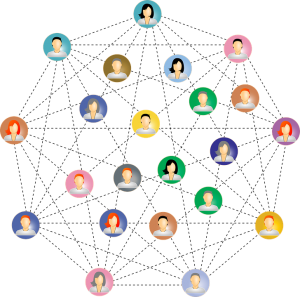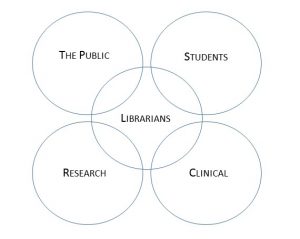May
17

Posted by Martha Meacham on May 17th, 2017
Posted in: Commentary
 If you listen to the worries and anxieties of other professions, one, you start to realize that they often have the same concerns as librarians; and two, you start to repeatedly hear about breaking down silos. We talk about silos in librarianship as well – which may be a topic for another day – but it seems to be a major and constant refrain in medicine, research, patient care, and the sciences in general – often because of the dramatic innovations that are possible and the depressing results when it doesn’t happen. In research, one lab won’t know want the lab next door is doing, even when they are working on very similar topics. In the clinic, the public health worker doesn’t realize that a problem they are facing is also being addressed by an internal medicine doctor. An intrepid student makes headway on a problem that has plagued a seasoned faculty. Those who work by the bedside don’t always know what is happening at the bench – let alone the public knowing what is going on. We all live in, and are concerned with, the bubbles immediately around us. Innovation and growth occur when we can get these bubbles to intersect.
If you listen to the worries and anxieties of other professions, one, you start to realize that they often have the same concerns as librarians; and two, you start to repeatedly hear about breaking down silos. We talk about silos in librarianship as well – which may be a topic for another day – but it seems to be a major and constant refrain in medicine, research, patient care, and the sciences in general – often because of the dramatic innovations that are possible and the depressing results when it doesn’t happen. In research, one lab won’t know want the lab next door is doing, even when they are working on very similar topics. In the clinic, the public health worker doesn’t realize that a problem they are facing is also being addressed by an internal medicine doctor. An intrepid student makes headway on a problem that has plagued a seasoned faculty. Those who work by the bedside don’t always know what is happening at the bench – let alone the public knowing what is going on. We all live in, and are concerned with, the bubbles immediately around us. Innovation and growth occur when we can get these bubbles to intersect.
 I propose that librarians serving any field or population – from health science to public librarians – are in the perfect position to help breakdown these silos – to serve as the intersection points for different bubbles. Librarians’ jobs necessitate that they interact with a wide variety of people and information within their institutions and beyond. Librarians are also masters at creating connections; from one resource to another, from a resource to a person, and hopefully, from person to person. We pride ourselves on ensuring access to information. Well, that guy you just helped could be the source of information someone else is looking for. Through our ability to organize and make connections, we could provide the access needed to bridge silos. Librarians are generally curious, inquisitive, and well informed. We also love to share what we know. You know the department you work with better than most. A public librarian knows her community and its needs intimately. A manager may see the business trends or funding implications well before others. A systems librarian knows the tech and works closely with the IT department. How can we work together to employ these connections and intersections, while using them to increase the access and innovation of our communities?
I propose that librarians serving any field or population – from health science to public librarians – are in the perfect position to help breakdown these silos – to serve as the intersection points for different bubbles. Librarians’ jobs necessitate that they interact with a wide variety of people and information within their institutions and beyond. Librarians are also masters at creating connections; from one resource to another, from a resource to a person, and hopefully, from person to person. We pride ourselves on ensuring access to information. Well, that guy you just helped could be the source of information someone else is looking for. Through our ability to organize and make connections, we could provide the access needed to bridge silos. Librarians are generally curious, inquisitive, and well informed. We also love to share what we know. You know the department you work with better than most. A public librarian knows her community and its needs intimately. A manager may see the business trends or funding implications well before others. A systems librarian knows the tech and works closely with the IT department. How can we work together to employ these connections and intersections, while using them to increase the access and innovation of our communities?
Many librarians already do this, and do it well. What I suggest is that the profession more consciously, explicitly, and deliberately leverage this skill and our positions at the intersections. Librarians are in a very unique position. We must promote ourselves as the facilitators, the connectors, the means to move others beyond their silos. Move beyond the question of, “How does this apply to me?” or “How does this apply to librarianship?” Rather ask, “How does this apply to those I serve?”, “Where is the connection and how can I position myself to provide information and service at that intersection?” Focusing on the informational connections between communities and people, rather than just the connection between the resource and the person, will be the strength librarianship needs.
Hopefully, the NNLM NER can serve to educate and facilitate all in our region on creating connections and building the skill necessary to break down silos. NNLM NER is in the unique position of interacting with a wide variety of fields – librarians of all strips, community organizations, scientists, researchers, students, the public, and so many others. We hope to break down the silos in our own region and for those we serve. I have seen the power of strong networks and connections. We are striving to make NNLM NER an example and leader.
Martha Meacham
(this is an editorial piece and does not necessary reflect the view of the New England Region, the National Network of Libraries of Medicine, or the National Library of Medicine)
 ABOUT Martha Meacham
ABOUT Martha Meacham